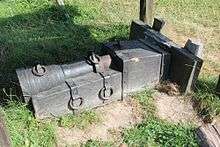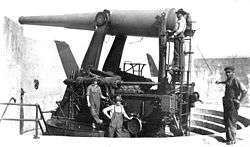Gun carriage
A gun carriage is a frame and mount that supports the gun barrel of an artillery piece, allowing it to be manoeuvred and fired.
Early guns

The earliest guns were laid directly onto the ground, with earth being piled up under the muzzle end of the barrel to increase the elevation. As the size of guns increased, they began to be attached to heavy wooden frames or beds that were held down by stakes. These began to be replaced by wheeled carriages in the early 16th century.[1]
Smoothbore gun carriages
From the 16th to the mid-19th century, the main form of artillery remained the smoothbore cannon. By this time, the trunnion (a short axle protruding from either side of the gun barrel) had been developed, with the result that the barrel could be held in two recesses in the carriage and secured with an iron band. This simplified elevation, which was achieved by raising or lowering the breech of the gun by means of a wedge called a quoin or later by a steel screw. During this time, the design of gun carriages evolved only slowly, with the trend being towards lighter carriages carrying barrels that were able to throw a heavier projectile. There were two main categories of gun carriages:
Naval or garrison carriages
These were designed for use aboard a ship or within a fortification and consisted of two large wooden slabs called "cheeks" held apart by bracing pieces called "transoms". The trunnions of the gun barrel sat on the top of the cheeks; the rearward part of each cheek was stepped so that the breech could be lifted by iron leavers called "handspikes". Because these guns were not required to travel about, they were only provided with four small wheels called "trucks", whose main function was to roll backwards with the recoil of the gun and then allow it to be moved forward into a firing position after reloading. Traversing the gun was achieved by levering the rear of the carriage sideways with handspikes.[2]
Field carriages
These were designed to allow guns to be deployed on the battlefield and were provided with a pair of large wheels similar to those used on carts or wagons. The cheeks of field carriages were much narrower than those on the naval carriage and the rear end, called a "trail", rested on the ground.[3] When the gun needed to be moved any distance, the trail could be lifted onto a second separate axle called a limber, which could then be towed by a team of horses or oxen. Limbers had been invented in France in about 1550.[4] An innovation from the mid-18th century was the invention of the "block trail", which replaced the heavy cheeks and transoms of the "double-bracket" carriage with a single wooden spar reinforced with iron.[5]
Modern gun carriages
In recent times, most heavy guns in military service, that were not themselves mounted into a vehicles, have been mounted either with a field carriage or a spit trail carriage. The field carriage is simpler - having two legs extend backwards, joining at a tail, being a hardpoint to hook on to a prime mover or set of horses. The split trail carriage, however, is more complicated, but offers distinct advantages. It consists of two legs, able to be spread independently to the sides, or brought together to allow towing or movement.
In both cases, the tail of the carriage often serves to balance the gun, and protect it from rolling to any large extent. The split trail, however, allows the gun not only to be fired near the horizontal, as the field carriage does, but also at angles to main line of the gun. This is less important for heavier artillery, as the guns already involve a long time to prepare a firing position. With smaller support guns, the ability to redirect fire from one area to another, as well as "track" a moving target, is key, and thus many lighter guns, as well as most modern artillery pieces, have split trail carriages.
Some guns, such as the L118 light 105mm howitzer, or its predecessor, the 25-pounder, adapted around the problems associated with a field carriage by installing a disc under the wheelbase, upon which the gun can rotate a full 360 degrees. While this still limits the gun's ability to track, it allows the guns to fire in any direction with minimal preparation. Furthermore, it retains part of each of the benefits of the field carriage, being weight, space, and complexity.
Gallery
-
French de Bange 155 mm cannon of 1877, with a solid field carriage.
-

US 10-inch coastal artillery gun on an 1896 disappearing carriage
-

French Canon de 75 modèle 1897
-
German 88 mm Flak 37 anti-aircraft gun of 1937 on an anti-aircraft carriage.
-

British Ordnance QF 25-pounder gun/howitzer of 1940 with its distinct rotary field carriage.
-

US 155 mm Long Tom field gun
-

British L118 light gun being carried by a Merlin helicopter
References
- ↑ Manucy, Albert C (1949), Artillery Through the Ages: A Short Illustrated History of Cannon, National Park Service, Washington DC (pp. 3-5)
- ↑ Manucy (pp. 46-51)
- ↑ Manucy (p. 54)
- ↑ Manucy (p. 5)
- ↑ Dawson, Anthony Leslie (August 2011) [February 2006]. "Some Notes on the Royal Artillery in the Peninsula 1808". www.napoleon-series.org. The Napoleon Series. Retrieved 2 June 2014.